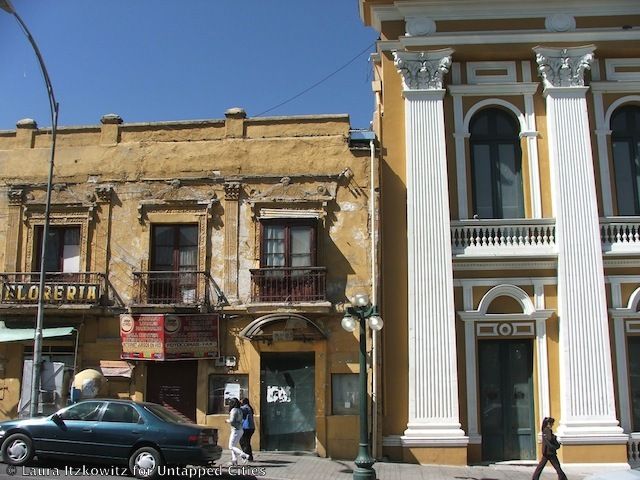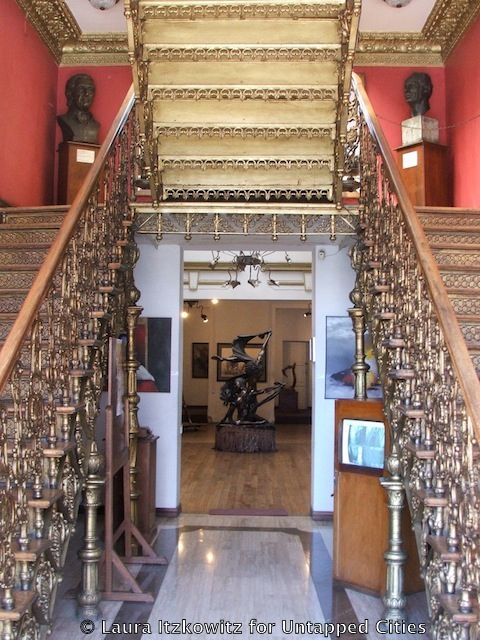


La Paz, Bolivia: a city full of juxtapositions. Aymara women with bowler hats and colorful aguayos on their backs cross paths with university students wearing European soccer jerseys. Bolivians selling bootleg DVDs of American movies have set up their booths across from cafes selling empanadas and papaya juice. Cars so old and run down they look like they might fall apart at any minute lumber up the steeply inclined streets and around Plaza Murillo, the main square where President Morales (Bolivia’s first indigenous president) governs.
One of the most striking things about the city is the European architecture that’s often crumbling in disrepair. It immediately reminds visitors of Bolivia’s colonial history. Yet, as an outsider looking in, it’s hard to sort through the overwhelming combination of architectural styles that have collided over the course of nearly two hundred years of Bolivian independence. Who would have expected to find a building designed by the same man who designed the Eiffel Tower? After all, he was French, and Bolivia was colonized by the Spanish.

I spent my first afternoon in La Paz wandering around the center of the city, from Plaza San Francisco up the Prado towards Plaza Murillo. The Prado is one of the main streets in La Paz, and it’s wide enough to have traffic on either side flanking a pedestrian walkway with benches and trees. On one side of the street was a garishly-colored fast food restaurant where schoolkids in uniforms flocked to eat bubblegum pink ice cream. I was walking along the other side of the street when the word “Museo” stopped me in my tracks.
My curiosity led me into the Museo de Arte Contemporaneo, a well-preserved European style building surrounded by abandoned storefronts. I quickly realized that this is no ordinary museum. The paintings on the walls had not only a placard with the artist’s name and title of the work, but also a price. It seemed strange to have price tags on the paintings in a museum– usually you only see that in galleries. Downstairs, in the main room, there was a temporary exhibit of paintings inspired by tango. I wondered what kind of art museum this is, and what kind of art they’re endorsing.
However, it wasn’t the art itself that intrigued me, as most of the paintings were fairly conventional in style. Instead, I was fascinated by the architecture. Immediately upon entering the museum, I was faced with a wrought iron staircase painted gold against red walls. The rooms were spacious with high ceilings and moldings where chandeliers once hung. Upstairs, a large stained glass window framed a golden sculpture of a woman. I was surprised to find such a classic Beaux Arts style building in downtown La Paz. It looked like it could have been airlifted out of Paris and set down on the Prado. I wanted to know: what was the story behind this building?


My interpreter kindly asked the man behind the front desk to tell us about the history of the museum. It turns out that the museum was built over one hundred years ago as a home for important aristocratic families. Indeed, the skylight on the top floor was designed by Gustave Eiffel, the architect who designed the Eiffel Tower. He also designed the original train station in La Paz, which now serves as a bus terminal. A little digging reveals that before Eiffel designed the Eiffel Tower for the 1889 Exposition Universelle, he designed buildings throughout Europe and Latin America, including in Peru, Chile and Mexico. Fortunately, his designs have been conserved and are there for Bolivians and tourists alike to enjoy.
However, both the architecture and the art in the Museo de Arte Contemporaneo seem to reinforce a rather elitist idea about the art scene in La Paz. This was indeed echoed to me by a Bolivian friend who told me that the art museums in Bolivia are very exclusive and not very open to new artists and their ideas. In order to overcome these challenges, many young artists are banding together and forming collectives where they can share and promote each other’s work. Check back soon for coverage of the Casa Abierta de Arte, an independently organized art open house featuring young Bolivian artists.


Get in touch with the author @lauraitzkowitz.

